- Flowering Period:June, July, August, September
- Final height:80cm to 100cm
- Final width:80cm to 100cm
- Available:February, March, April, May, June, July, August, September, October, November
- Fragrances:lightly scented
- Use:beds/borders, for containers, as a hedge, for group plantings, as a specimen plant
- Hardiness:hardy
- Soil:moist, heavy, moderately heavy, neutral, acidic, slightly acidic
- Location:partial shade
- Flower Colour:pink, grey
- Leaf Colour:green
-
Out of stock
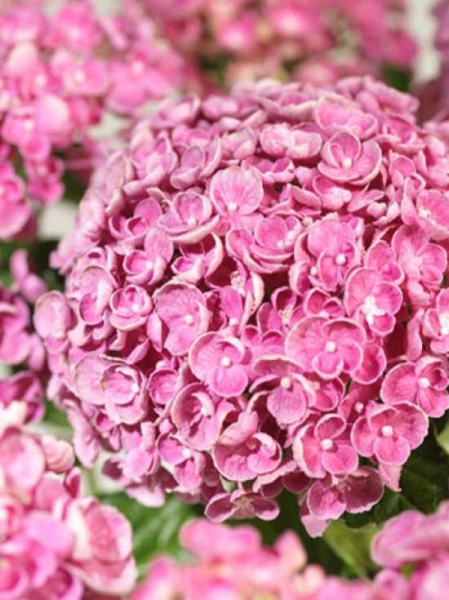
-
Out of stock
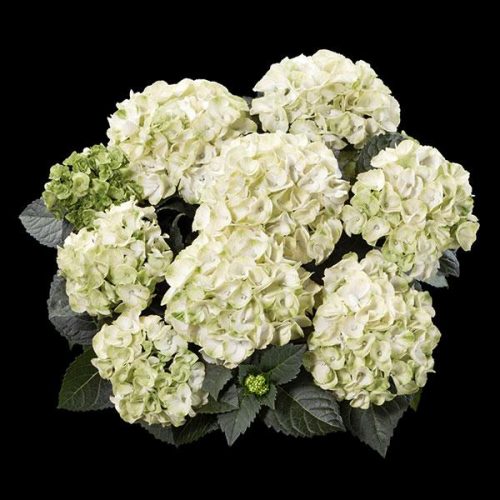 Hydrangea Macrophylla Caipirinha is a compact deciduous shrub with dark green ovate toothed leaves. During the summer it has beautiful rounded clusters of white mop head flowers fading with age to dark green with a red border around each petal at the end of the flower. Eventual height and spread up to 1.2 metres pot size: 3L
Hydrangea Macrophylla Caipirinha is a compact deciduous shrub with dark green ovate toothed leaves. During the summer it has beautiful rounded clusters of white mop head flowers fading with age to dark green with a red border around each petal at the end of the flower. Eventual height and spread up to 1.2 metres pot size: 3L -
Out of stock
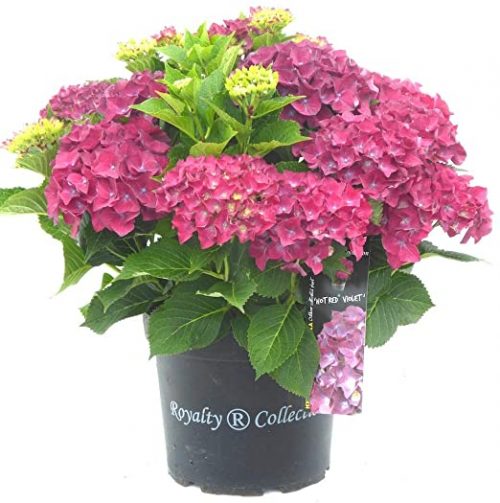 A medium sized deciduous shrub with deep purple/pink-red mophead blooms in summer above dark purple tinged green foliage, when grown in neutral to alkaline soils. Flowers in summer and may change to blue/mauve shades when grown on acidic soils or pink on neutral soils.
A medium sized deciduous shrub with deep purple/pink-red mophead blooms in summer above dark purple tinged green foliage, when grown in neutral to alkaline soils. Flowers in summer and may change to blue/mauve shades when grown on acidic soils or pink on neutral soils.- Flower Colour: Pink, Red
- Flower Type: Mophead
- Flowering Month: June, July, August, September
- Soil Type: Alkaline, Normal
- Aspect: Partial Shade
- Hardiness*: Hardy
- Foliage Type: Deciduous
- Foliage Colour: Green, Bronze/purple
- Height after 10 years*: 0.9-1.2m (3-4ft)
- Pot Size: 3 Litre
-
Out of stock
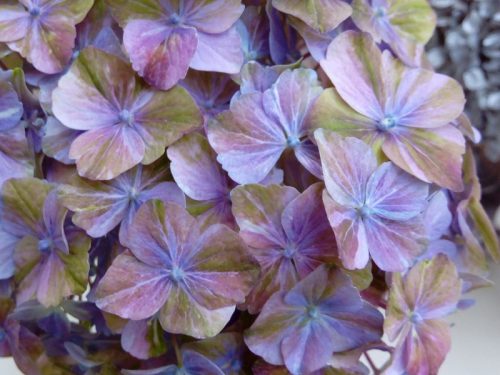 Large purple-green mophead shaped flowerheads with frilly edges when grown in neutral to alkaline soils. Position: They perform best when given a shady, cool moist root run and a sheltered aspect. Maintenance: Mophead hydrangeas require little pruning, simply thin out old stems and remove the dead flowers to a pair of plump green buds in late spring.
Large purple-green mophead shaped flowerheads with frilly edges when grown in neutral to alkaline soils. Position: They perform best when given a shady, cool moist root run and a sheltered aspect. Maintenance: Mophead hydrangeas require little pruning, simply thin out old stems and remove the dead flowers to a pair of plump green buds in late spring.- Flower Colour: Green, Purple
- Flower Type: Mophead
- Flowering Month: June, July, August, September
- Soil Type: Alkaline, Normal
- Aspect: Partial Shade
-
Out of stock
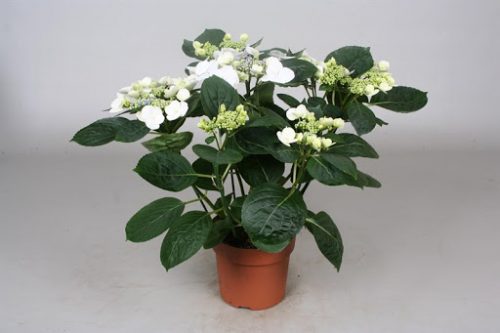
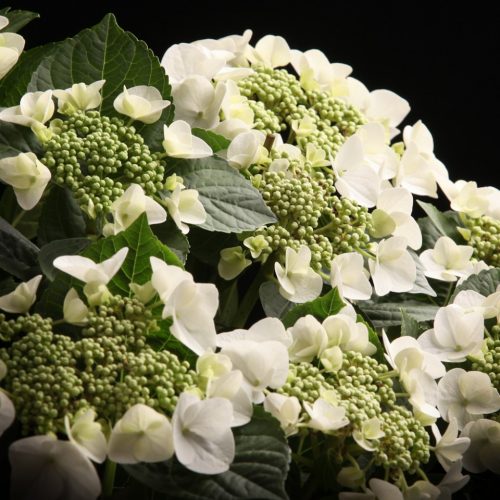 Hydrangea macrophylla ‘Benxi’ Shrubbery suitable for the rock garden rich, fresh, as preferable exposure Partial shade – Shade color White Flowering period is June – September Height 100 cm – 120 cm Density 1 potted seedlings per square meter, Diameter pot 19cm
Hydrangea macrophylla ‘Benxi’ Shrubbery suitable for the rock garden rich, fresh, as preferable exposure Partial shade – Shade color White Flowering period is June – September Height 100 cm – 120 cm Density 1 potted seedlings per square meter, Diameter pot 19cm -
Out of stock
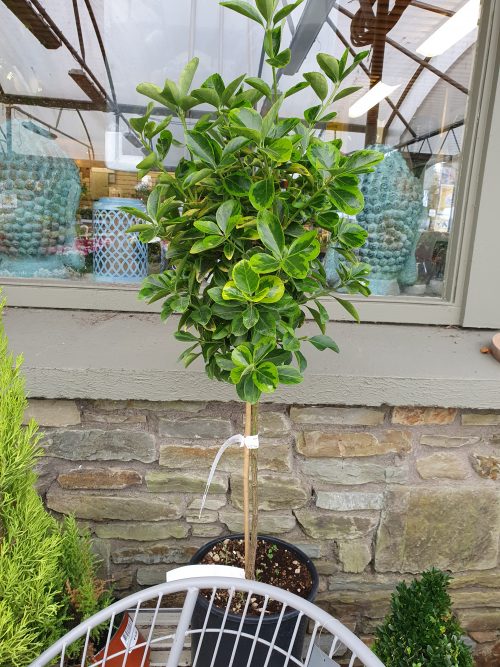
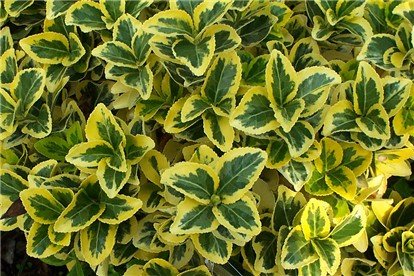 Euonymus japonicus Aureus is an evergreen variety and provides year round interest. Excellent for growing as a specimen shrub or small hedge. Also suitable for coastal areas. The attractive leathery leaves are dark green with bright yellow edges.A Decorative Foliage
Euonymus japonicus Aureus is an evergreen variety and provides year round interest. Excellent for growing as a specimen shrub or small hedge. Also suitable for coastal areas. The attractive leathery leaves are dark green with bright yellow edges.A Decorative Foliage- Pot size: 7.5L
- Height: 4m
- Spread: 2m
- Leaf colour: variegated
- Plant location: sunny
- Plant depth: 15 cm
- Hardiness: -15 Celsius
- Harmful if eaten
- Preferred soil: Grows in any soil
-
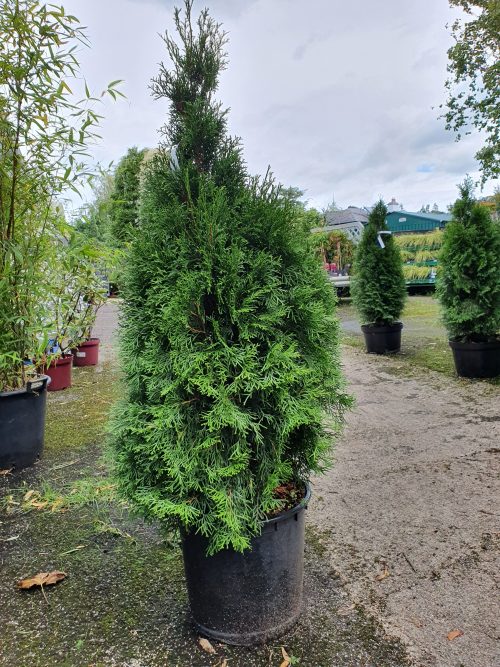 A slow growing, evergreen, erect conifer, Thuja occidentalis Smaragd has scale-like, fresh green leaves that are held closely to the shoots and give a fresh apple-like aroma when crushed. With its narrow, conical shape, Smaragd makes a useful tree for any garden, and is particularly suitable for formal plantings either as an individual specimen or in rows. It is slow to reach its eventual height of around 8-10ft but the narrow, conical shape will broaden out with maturity to reach a diameter of around 6ft. Pot size: 20L Actual height: 100-125cm Site: Very tolerant of inland exposure Soil: Well drained, tolerates clay soils, shallow over chalky soils Position: Full sun, tolerates partial shade Season of Interest: All year round and aromatic foliage Hardiness: Fully hardy Height: 5-8ft (1.5-2.5m) Spread: 3-6ft (1-2m)
A slow growing, evergreen, erect conifer, Thuja occidentalis Smaragd has scale-like, fresh green leaves that are held closely to the shoots and give a fresh apple-like aroma when crushed. With its narrow, conical shape, Smaragd makes a useful tree for any garden, and is particularly suitable for formal plantings either as an individual specimen or in rows. It is slow to reach its eventual height of around 8-10ft but the narrow, conical shape will broaden out with maturity to reach a diameter of around 6ft. Pot size: 20L Actual height: 100-125cm Site: Very tolerant of inland exposure Soil: Well drained, tolerates clay soils, shallow over chalky soils Position: Full sun, tolerates partial shade Season of Interest: All year round and aromatic foliage Hardiness: Fully hardy Height: 5-8ft (1.5-2.5m) Spread: 3-6ft (1-2m) -
Out of stock
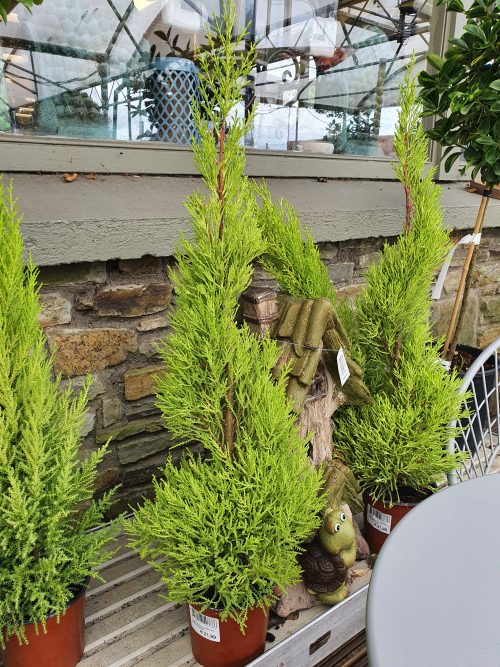
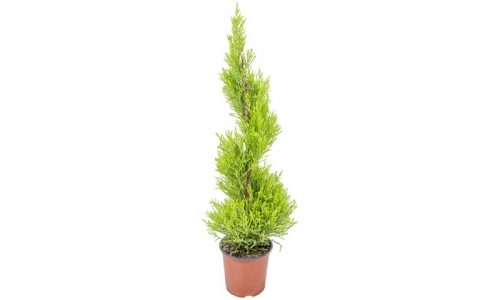 Cupressus macrocarpa 'Goldrest Wilma' is one of the most attractive golden-foliage columnar conifers. Bright golden-yellow foliage. Any free-draining soil in sun or partial shade. Rate of growth up to 60cm per year. Can be used for hedging but doesn't trim quite as well as leylandii. If used for hedging, plant 60-90cm apart. Can be trimmed to keep at the required height Plant Size • Mature Height: 10m • Mature Spread: 2-3m Why We Love It • These trees work wonderfully as topiaries • Fresh lemony scent • Easy to maintain What To Know • Fruit Season: Fall • Position: Full sun • Soil: Well drained • Rate of Growth: Moderate to fast How to Care • In general, growing lemon cypress is not difficult. The trees require well-draining soil, but are not picky about whether it is loamy, sandy or chalky. They also accept acidic, neutral or alkaline soil. • Water regularly - weekly, or more often in extreme heat or containers. • Trimming/Pruning If this plant is used for hedging, it will need to be pruned regularly. It will have to be trimmed to maintain the required height. Use sharp pruning shears to remove the sucker branches and the errant branches that are growing in the wrong direction or making it difficult to fertilize the tree. Since lemon cypress has a conical habit, trim the tree as per its natural shape. Trimming should be done every week during the summer. • Fertilizer Fertilize with the standard, slow-releasing fertilizer that has an equal amount of nitrogen, phosphorus, and potassium once a month. You can also supplement the soil annually with turf fertilizers that contain other nutrients such as magnesium, boron, copper, and zinc
Cupressus macrocarpa 'Goldrest Wilma' is one of the most attractive golden-foliage columnar conifers. Bright golden-yellow foliage. Any free-draining soil in sun or partial shade. Rate of growth up to 60cm per year. Can be used for hedging but doesn't trim quite as well as leylandii. If used for hedging, plant 60-90cm apart. Can be trimmed to keep at the required height Plant Size • Mature Height: 10m • Mature Spread: 2-3m Why We Love It • These trees work wonderfully as topiaries • Fresh lemony scent • Easy to maintain What To Know • Fruit Season: Fall • Position: Full sun • Soil: Well drained • Rate of Growth: Moderate to fast How to Care • In general, growing lemon cypress is not difficult. The trees require well-draining soil, but are not picky about whether it is loamy, sandy or chalky. They also accept acidic, neutral or alkaline soil. • Water regularly - weekly, or more often in extreme heat or containers. • Trimming/Pruning If this plant is used for hedging, it will need to be pruned regularly. It will have to be trimmed to maintain the required height. Use sharp pruning shears to remove the sucker branches and the errant branches that are growing in the wrong direction or making it difficult to fertilize the tree. Since lemon cypress has a conical habit, trim the tree as per its natural shape. Trimming should be done every week during the summer. • Fertilizer Fertilize with the standard, slow-releasing fertilizer that has an equal amount of nitrogen, phosphorus, and potassium once a month. You can also supplement the soil annually with turf fertilizers that contain other nutrients such as magnesium, boron, copper, and zinc -
Out of stock
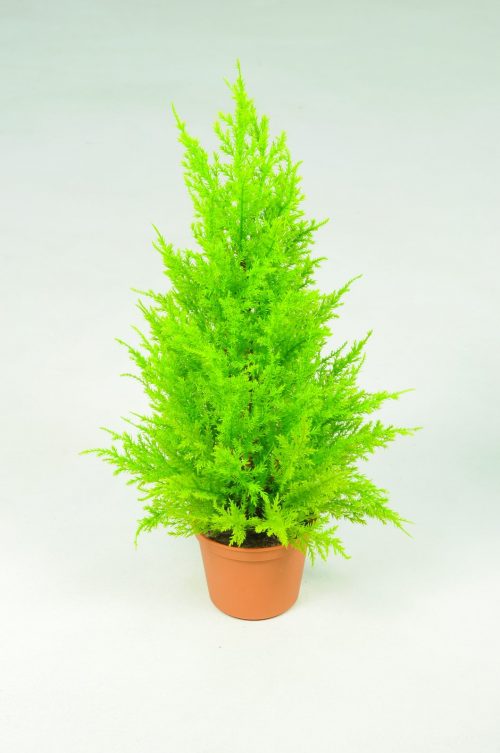 Cupressus macrocarpa 'Goldrest Wilma' is one of the most attractive golden-foliage columnar conifers. Bright golden-yellow foliage. Any free-draining soil in sun or partial shade. Rate of growth up to 60cm per year. Can be used for hedging but doesn't trim quite as well as leylandii. If used for hedging, plant 60-90cm apart. Can be trimmed to keep at the required height Plant Size • Mature Height: 10m • Mature Spread: 2-3m Why We Love It • These trees work wonderfully as topiaries • Fresh lemony scent • Easy to maintain What To Know • Fruit Season: Fall • Position: Full sun • Soil: Well drained • Rate of Growth: Moderate to fast How to Care • In general, growing lemon cypress is not difficult. The trees require well-draining soil, but are not picky about whether it is loamy, sandy or chalky. They also accept acidic, neutral or alkaline soil. • Water regularly - weekly, or more often in extreme heat or containers. • Trimming/Pruning If this plant is used for hedging, it will need to be pruned regularly. It will have to be trimmed to maintain the required height. Use sharp pruning shears to remove the sucker branches and the errant branches that are growing in the wrong direction or making it difficult to fertilize the tree. Since lemon cypress has a conical habit, trim the tree as per its natural shape. Trimming should be done every week during the summer. • Fertilizer Fertilize with the standard, slow-releasing fertilizer that has an equal amount of nitrogen, phosphorus, and potassium once a month. You can also supplement the soil annually with turf fertilizers that contain other nutrients such as magnesium, boron, copper, and zinc
Cupressus macrocarpa 'Goldrest Wilma' is one of the most attractive golden-foliage columnar conifers. Bright golden-yellow foliage. Any free-draining soil in sun or partial shade. Rate of growth up to 60cm per year. Can be used for hedging but doesn't trim quite as well as leylandii. If used for hedging, plant 60-90cm apart. Can be trimmed to keep at the required height Plant Size • Mature Height: 10m • Mature Spread: 2-3m Why We Love It • These trees work wonderfully as topiaries • Fresh lemony scent • Easy to maintain What To Know • Fruit Season: Fall • Position: Full sun • Soil: Well drained • Rate of Growth: Moderate to fast How to Care • In general, growing lemon cypress is not difficult. The trees require well-draining soil, but are not picky about whether it is loamy, sandy or chalky. They also accept acidic, neutral or alkaline soil. • Water regularly - weekly, or more often in extreme heat or containers. • Trimming/Pruning If this plant is used for hedging, it will need to be pruned regularly. It will have to be trimmed to maintain the required height. Use sharp pruning shears to remove the sucker branches and the errant branches that are growing in the wrong direction or making it difficult to fertilize the tree. Since lemon cypress has a conical habit, trim the tree as per its natural shape. Trimming should be done every week during the summer. • Fertilizer Fertilize with the standard, slow-releasing fertilizer that has an equal amount of nitrogen, phosphorus, and potassium once a month. You can also supplement the soil annually with turf fertilizers that contain other nutrients such as magnesium, boron, copper, and zinc -
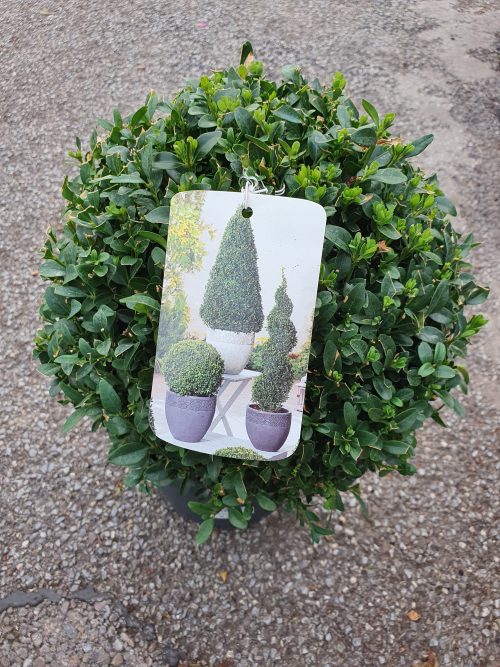
- Position: partial shade
- Soil: fertile, well-drained soil
- Rate of growth: slow-growing
- Hardiness: fully hardyA pair of these tightly clipped box spheres look great flanking a set of steps, a doorway or a path. One of our recommended plants, they're perfect for planting in a large terracotta pot in a partially shady site, where the glossy, dark-green leaves provide all year foliage, interest and structure. Box are happy growing in a sunnier spot, but the combination of dry soil and full sun may encourage poor growth and leaf scorching. If you have sandy soil it is best to keep them in a partially shady spot in the garden.
- Garden care: Ensure that the soil or compost is never allowed to dry out. Trim plants grown as hedges or topiary in mid- or late summer. If you want to maintain a really precise outline, then you can clip it twice a year - once in June, and then again in August/September. Apply a top-dressing of a balanced slow-release fertiliser such as blood, fish and bone (organic) or Growmore (inorganic) around the base of the plant in spring, making sure that none touches the leaves or stems.
-
Out of stock
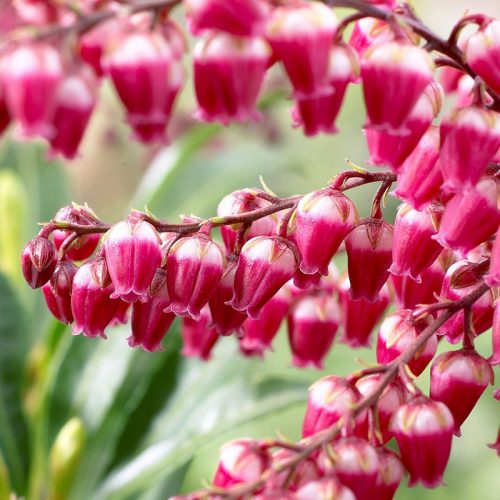
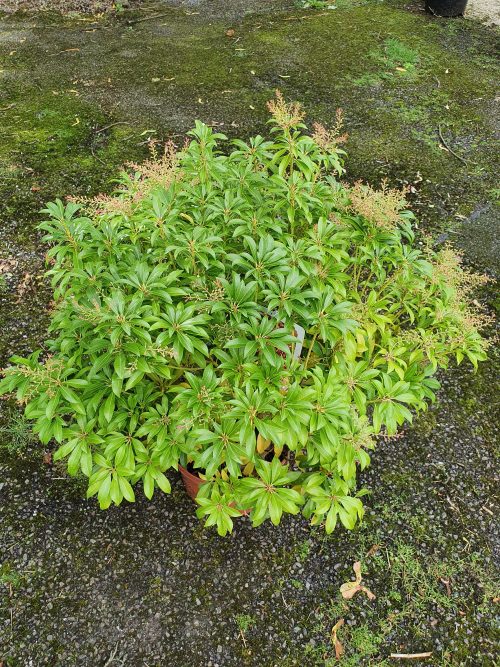 Reaching up to around a metre tall and wide, the attractive foliage is variegated in creamy white or even light yellow. The show stopping flowers are the real star and what makes this plant unique, being the first ever variegated Pieris variety to carry the masses of lily-of-the-valley-like flowers in deep red-purple. The plant is attractive in bud as they form over several weeks, to burst out in all their glory in Spring, lasting for several weeks. Later on, new shoots on the plant are produced in vivid shades of burgundy-scarlet-red, making for season long interest, and a real winner of an evergreen plant for the patio or garden. The blooms even carry a light fragrance. This Pieris is perfect for a mixed border among dwarf conifers, combined with other shrubs and evergreen, or it will simply also look great in a large pot on a patio.
Reaching up to around a metre tall and wide, the attractive foliage is variegated in creamy white or even light yellow. The show stopping flowers are the real star and what makes this plant unique, being the first ever variegated Pieris variety to carry the masses of lily-of-the-valley-like flowers in deep red-purple. The plant is attractive in bud as they form over several weeks, to burst out in all their glory in Spring, lasting for several weeks. Later on, new shoots on the plant are produced in vivid shades of burgundy-scarlet-red, making for season long interest, and a real winner of an evergreen plant for the patio or garden. The blooms even carry a light fragrance. This Pieris is perfect for a mixed border among dwarf conifers, combined with other shrubs and evergreen, or it will simply also look great in a large pot on a patio. -
Out of stock
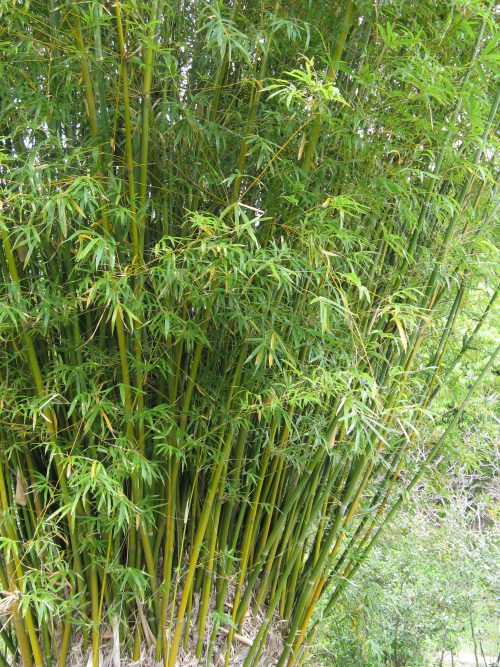
 Phyllostachys are the most common of the bamboos, tall, clump forming but not invasive and evergreen, the aurea are large with bright green stems that yellow with age. Grows tall up to 4 metres and clumps well in a sheltered position. Makes an unusual but effective hedge.
Phyllostachys are the most common of the bamboos, tall, clump forming but not invasive and evergreen, the aurea are large with bright green stems that yellow with age. Grows tall up to 4 metres and clumps well in a sheltered position. Makes an unusual but effective hedge.- Size: 12 litre pot
- Actual size: 150-175cm
- Mature Height : 4m - 8m
- Mature Spread : 2m - 2.5m
- Flower Colour : None or Insignificant
- Flowering Time : None or Insignificant
- Foliage : Evergreen
- Fragrant : No
- Growth Rate : Fast
- Hardiness : Fully Hardy
- Position : Full sun, Partial shade
- Soil Moisture : Moist Well-drained
- Soil PH : Acid, Neutral, Alkaline
- Soil Type : Loam
-
Out of stock
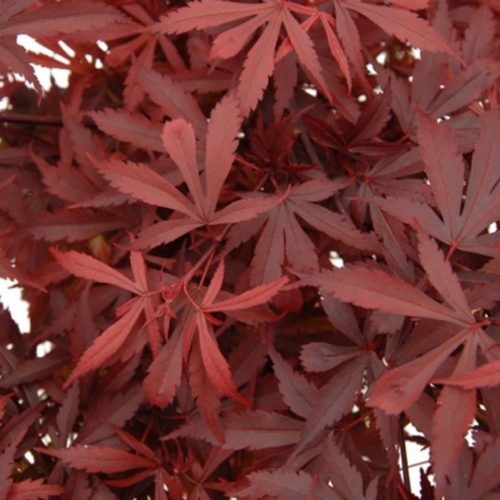 A small deciduous tree that has been in cultivation in Japan for a very long time. The fresh, delicate looking foliage is almost transparent in the sunlight and the overall shape of Japanese Maples make them an excellent choice as a specimen tree in a sheltered spot. Acer Palmatum Atropurpureum is the dark purple-leaved form of the common Japanese maple with exceptionally great Autumn colour. Growing notes: Acer palmatum and its cultivars are slow growing and do not really require pruning, but will tolerate it if necessary - remove damaged, diseased or crossing branches - it is best done during the dormant months. Lower branches can be taken off to shape the canopy over time. Japanese maples all require shelter from wind to avoid wind scorch. The very fine leaved cultivars need extra protection from wind and the sun. Despite being hardy, the fresh growth can be vulnerable to frost in the Spring. They all tolerate growing in a large container, some for a very long time.
A small deciduous tree that has been in cultivation in Japan for a very long time. The fresh, delicate looking foliage is almost transparent in the sunlight and the overall shape of Japanese Maples make them an excellent choice as a specimen tree in a sheltered spot. Acer Palmatum Atropurpureum is the dark purple-leaved form of the common Japanese maple with exceptionally great Autumn colour. Growing notes: Acer palmatum and its cultivars are slow growing and do not really require pruning, but will tolerate it if necessary - remove damaged, diseased or crossing branches - it is best done during the dormant months. Lower branches can be taken off to shape the canopy over time. Japanese maples all require shelter from wind to avoid wind scorch. The very fine leaved cultivars need extra protection from wind and the sun. Despite being hardy, the fresh growth can be vulnerable to frost in the Spring. They all tolerate growing in a large container, some for a very long time.- Cultivars with green or yellow foliage are best grown in dappled shade as full sun can scorch the leaves.
- Cultivars with purple or red foliage require some sun to fully develop their dark colour.
- Cultivars with variegated foliage require shade from the afternoon sun to prevent scorching.
-
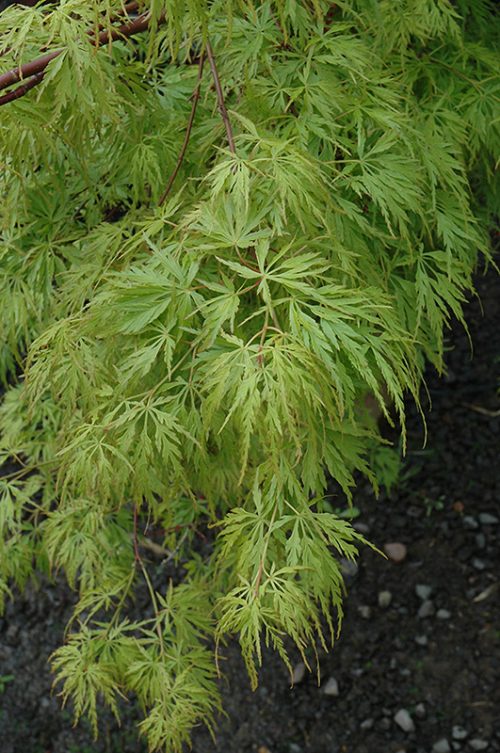 This lovely, green, dissected leafed Japanese Maple tree makes for a colourful splash in the garden. The lacy foliage is a bright, lime green throughout the spring and mid green in the summer, sometimes with a red tinge, before turning gold and red in the autumn. Acer palmatum dissectum 'Seiryu' is an unusual variety, as it is the only green dissected Japanese Maple tree with an upright growth habit, rather than the usual domed or weeping forms. Acer Seiryu has a striking vase shape which broadens slightly to a rounder form with age, eventually reaching a height and spread of 4 x 4 metres in 20 years. This dissected Acer tree is best positioned in a moist, well-drained soil in slight shade although it is tolerant of full sun. Acer palmatum 'Seiryu' makes a fantastic large shrub or small garden tree that offers an attractive, light canopy throughout the spring, summer and autumn. Pot size: 3L
This lovely, green, dissected leafed Japanese Maple tree makes for a colourful splash in the garden. The lacy foliage is a bright, lime green throughout the spring and mid green in the summer, sometimes with a red tinge, before turning gold and red in the autumn. Acer palmatum dissectum 'Seiryu' is an unusual variety, as it is the only green dissected Japanese Maple tree with an upright growth habit, rather than the usual domed or weeping forms. Acer Seiryu has a striking vase shape which broadens slightly to a rounder form with age, eventually reaching a height and spread of 4 x 4 metres in 20 years. This dissected Acer tree is best positioned in a moist, well-drained soil in slight shade although it is tolerant of full sun. Acer palmatum 'Seiryu' makes a fantastic large shrub or small garden tree that offers an attractive, light canopy throughout the spring, summer and autumn. Pot size: 3L -
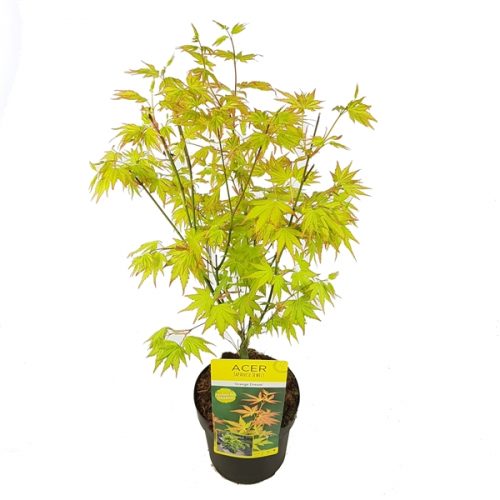
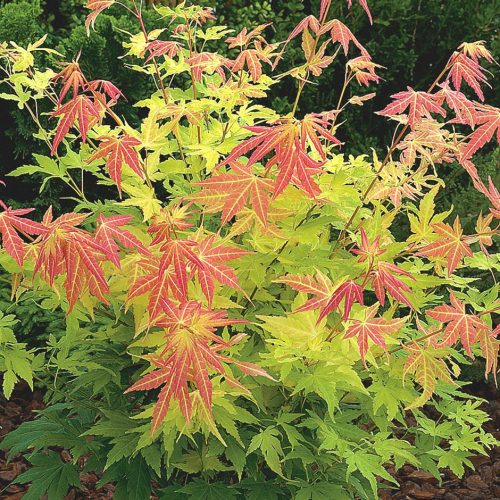 Orange Dream' is a medium sized bushy deciduous shrub, to 3m, with leaf colour varying at different seasons, yellow in spring, greenish in summer, orange-yellow in autumn. Bark is bright green. Redddish-purple flowers may be followed by red fruits Pot size: 3L Plant Size • Mature Height: 2.5-4 metres • Mature Spread: 2.5-4 metres Why We Love It • Perfect as a spciment plant in cottage gardens, city gardens or for rock gardens an containers • Low maintenace What To Know • Season of Interest: Spring-Autumn • Position: Full sun, partial shade • Soil: Moist but well drained, organically rich How to Care • Pruning should be carried out in the dormant season (November to March) as Japanese Maples bleed during other times of the year, which can weaken the branches. • Water in summer if necessary. • Leaf colour is best in partial shade, although full sun can be tolerated. • Add a top-dressing of a well-balanced fertiliser around the base of a recently planted tree in late spring and keep it well watered. No routine pruning is required, just remove any dead, damaged or crossing branches in late autumn or winter when they are fully dormant.
Orange Dream' is a medium sized bushy deciduous shrub, to 3m, with leaf colour varying at different seasons, yellow in spring, greenish in summer, orange-yellow in autumn. Bark is bright green. Redddish-purple flowers may be followed by red fruits Pot size: 3L Plant Size • Mature Height: 2.5-4 metres • Mature Spread: 2.5-4 metres Why We Love It • Perfect as a spciment plant in cottage gardens, city gardens or for rock gardens an containers • Low maintenace What To Know • Season of Interest: Spring-Autumn • Position: Full sun, partial shade • Soil: Moist but well drained, organically rich How to Care • Pruning should be carried out in the dormant season (November to March) as Japanese Maples bleed during other times of the year, which can weaken the branches. • Water in summer if necessary. • Leaf colour is best in partial shade, although full sun can be tolerated. • Add a top-dressing of a well-balanced fertiliser around the base of a recently planted tree in late spring and keep it well watered. No routine pruning is required, just remove any dead, damaged or crossing branches in late autumn or winter when they are fully dormant. -
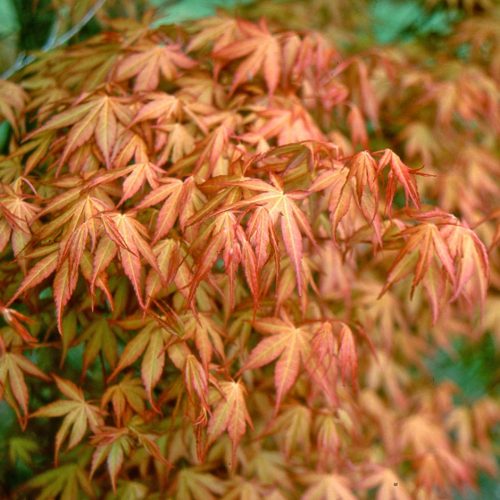 Acer Katsura is a stunning maple with beautiful orange - yellow leaves tinged with a reddish hue that change colour throughout the season. This deciduous variety looks stunning all spring, summer and especially in autumn. Pot size: 3L Position: full sun (but not south-facing) Soil: fertile, moist, well-drained neutral to acid soil Rate of growth: slow-growing Flowering period: April to May Hardiness: fully hardy Garden care: Add a top-dressing of a well-balanced fertiliser around the base of a recently planted tree in late spring and keep it well watered. No routine pruning is required, just remove any dead, damaged or crossing branches in late autumn or winter when they are fully dormant. Eventual Height: 4m Eventual Spread: 4m
Acer Katsura is a stunning maple with beautiful orange - yellow leaves tinged with a reddish hue that change colour throughout the season. This deciduous variety looks stunning all spring, summer and especially in autumn. Pot size: 3L Position: full sun (but not south-facing) Soil: fertile, moist, well-drained neutral to acid soil Rate of growth: slow-growing Flowering period: April to May Hardiness: fully hardy Garden care: Add a top-dressing of a well-balanced fertiliser around the base of a recently planted tree in late spring and keep it well watered. No routine pruning is required, just remove any dead, damaged or crossing branches in late autumn or winter when they are fully dormant. Eventual Height: 4m Eventual Spread: 4m -
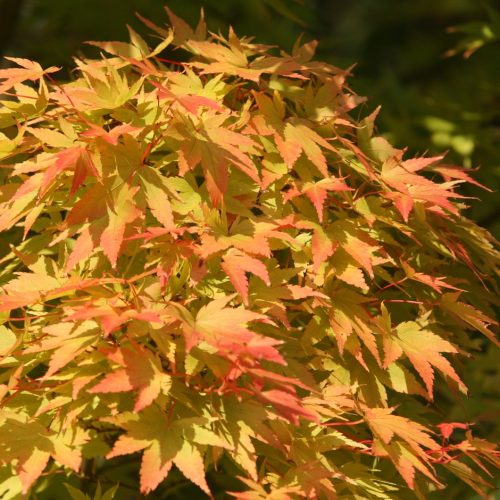 Acer 'Sangokaku' is a compact, bushy acer growing to 5m tall in 10 years. The leaves emerge green in spring, turning a yellow, orange before falling. Pot Size: 5L Plant Size • Mature Height: 5m • Mature Spread: 2m Why We Love It • Perfect as a spciment plant in cottage gardens, city gardens or for rock gardens an containers • Low maintenace What To Know • Season of Interest: Spring-Autumn • Position: Full sun, partial shade • Soil: Moist but well drained, organically rich How to Care • Pruning should be carried out in the dormant season (November to March) as Japanese Maples bleed during other times of the year, which can weaken the branches. • Water in summer if necessary. • Leaf colour is best in partial shade, although full sun can be tolerated. • Add a top-dressing of a well-balanced fertiliser around the base of a recently planted tree in late spring and keep it well watered. No routine pruning is required, just remove any dead, damaged or crossing branches in late autumn or winter when they are fully dormant.
Acer 'Sangokaku' is a compact, bushy acer growing to 5m tall in 10 years. The leaves emerge green in spring, turning a yellow, orange before falling. Pot Size: 5L Plant Size • Mature Height: 5m • Mature Spread: 2m Why We Love It • Perfect as a spciment plant in cottage gardens, city gardens or for rock gardens an containers • Low maintenace What To Know • Season of Interest: Spring-Autumn • Position: Full sun, partial shade • Soil: Moist but well drained, organically rich How to Care • Pruning should be carried out in the dormant season (November to March) as Japanese Maples bleed during other times of the year, which can weaken the branches. • Water in summer if necessary. • Leaf colour is best in partial shade, although full sun can be tolerated. • Add a top-dressing of a well-balanced fertiliser around the base of a recently planted tree in late spring and keep it well watered. No routine pruning is required, just remove any dead, damaged or crossing branches in late autumn or winter when they are fully dormant. -
 Acer 'Sangokaku' is a compact, bushy acer growing to.5m tall in 10 years. The leaves emerge green in spring, turning a ellow, orange before falling. Pot Size: 3L Plant Size • Mature Height: 5m • Mature Spread: 2m Why We Love It • Perfect as a spciment plant in cottage gardens, city gardens or for rock gardens an containers • Low maintenace What To Know • Season of Interest: Spring-Autumn • Position: Full sun, partial shade • Soil: Moist but well drained, organically rich How to Care • Pruning should be carried out in the dormant season (November to March) as Japanese Maples bleed during other times of the year, which can weaken the branches. • Water in summer if necessary. • Leaf colour is best in partial shade, although full sun can be tolerated. • Add a top-dressing of a well-balanced fertiliser around the base of a recently planted tree in late spring and keep it well watered. No routine pruning is required, just remove any dead, damaged or crossing branches in late autumn or winter when they are fully dormant.
Acer 'Sangokaku' is a compact, bushy acer growing to.5m tall in 10 years. The leaves emerge green in spring, turning a ellow, orange before falling. Pot Size: 3L Plant Size • Mature Height: 5m • Mature Spread: 2m Why We Love It • Perfect as a spciment plant in cottage gardens, city gardens or for rock gardens an containers • Low maintenace What To Know • Season of Interest: Spring-Autumn • Position: Full sun, partial shade • Soil: Moist but well drained, organically rich How to Care • Pruning should be carried out in the dormant season (November to March) as Japanese Maples bleed during other times of the year, which can weaken the branches. • Water in summer if necessary. • Leaf colour is best in partial shade, although full sun can be tolerated. • Add a top-dressing of a well-balanced fertiliser around the base of a recently planted tree in late spring and keep it well watered. No routine pruning is required, just remove any dead, damaged or crossing branches in late autumn or winter when they are fully dormant. -
Out of stock
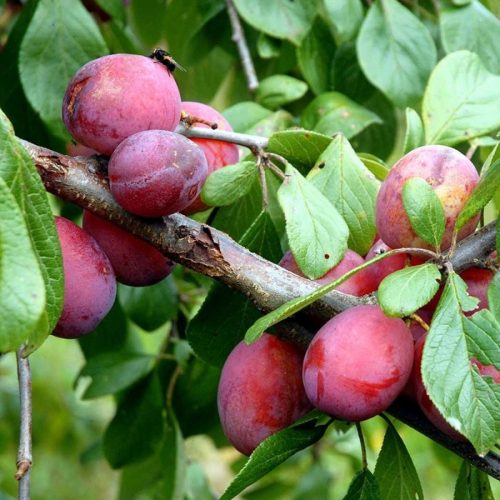 Plum ‘Opal’ is one of the most reliable garden varieties, and is suitable for growing throughout the country. Slightly earlier to crop than ‘Victoria’, this dessert plum produces a heavy crop of excellent quality, small, yellow skinned fruits with an attractive red flush in July and August. The golden flesh easily separates from its stone and has a delicious gage flavour. This variety is partially self-fertile. For the heaviest crops it is best grown with another or a similar variety.
Plum ‘Opal’ is one of the most reliable garden varieties, and is suitable for growing throughout the country. Slightly earlier to crop than ‘Victoria’, this dessert plum produces a heavy crop of excellent quality, small, yellow skinned fruits with an attractive red flush in July and August. The golden flesh easily separates from its stone and has a delicious gage flavour. This variety is partially self-fertile. For the heaviest crops it is best grown with another or a similar variety.- Size/Root Stock: 7-10 litre pot
- Mature Height : 3m - 4m
- Mature Spread : 3m - 4m
- Flower Colour : White
- Flowering Time : Spring
- Foliage : Deciduous
- Fragrant : No
- Growth Rate : Average
- Hardiness : Fully Hardy
- Position : Full sun
- Soil Moisture : Moist Well-drained, Well-drained
- Soil PH : Neutral
- Soil Type : Loam, Sand
-
Out of stock
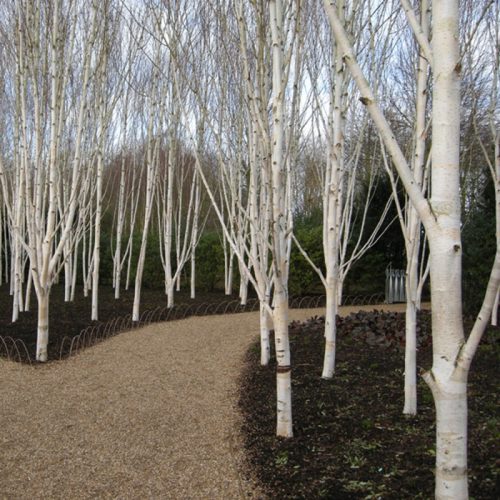 Betula Jacquemontii is a vigorous deciduous tree with brilliant white bark on the trunk and larger branches; ovate leaves turn yellow in autumn; yellow-brown male catkins open in early spring. CHARACTERISTICS:
Betula Jacquemontii is a vigorous deciduous tree with brilliant white bark on the trunk and larger branches; ovate leaves turn yellow in autumn; yellow-brown male catkins open in early spring. CHARACTERISTICS:- Soil: Moist, well-drained soil
- Max. Height & Spread: H-18 m or higher x S-10 m
- Season of Interest: Spring
- Position: Full Sun or Partial Shade
- Hardiness: Hardy
-
Out of stock
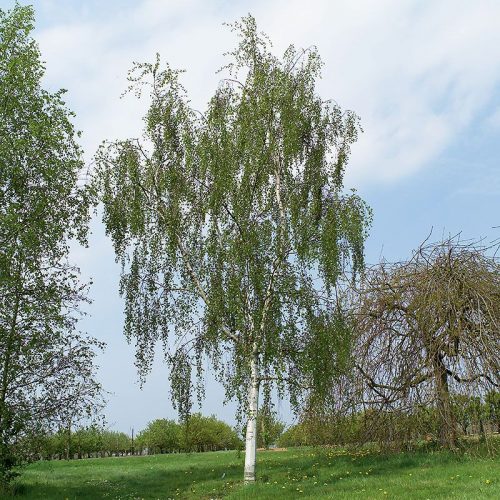 Betula Pendula Tristis is a tall and graceful tree with pendulous branches that are heavily weeping and twisted at the tips supporting a cloth of blue/green leaves. Catkins appear in the spring and the slightly serrated foliage turns creamy yellow in the autumn. This elegantly shaped birch tree casts a dappled shade and looks particularly attractive in the winter when its majestic form is fully revealed by bare branches. The beautiful, silvery smooth white bark provides year round interest and is a canvas to contrasting dark cracks and fissures that develop with age. Tristis is suited to most soil types and a 20 year height and spread of 7 x 4 metres can be expected. Pot size: 10L Height at the moment: 180cm-200cm
Betula Pendula Tristis is a tall and graceful tree with pendulous branches that are heavily weeping and twisted at the tips supporting a cloth of blue/green leaves. Catkins appear in the spring and the slightly serrated foliage turns creamy yellow in the autumn. This elegantly shaped birch tree casts a dappled shade and looks particularly attractive in the winter when its majestic form is fully revealed by bare branches. The beautiful, silvery smooth white bark provides year round interest and is a canvas to contrasting dark cracks and fissures that develop with age. Tristis is suited to most soil types and a 20 year height and spread of 7 x 4 metres can be expected. Pot size: 10L Height at the moment: 180cm-200cm -
Out of stock
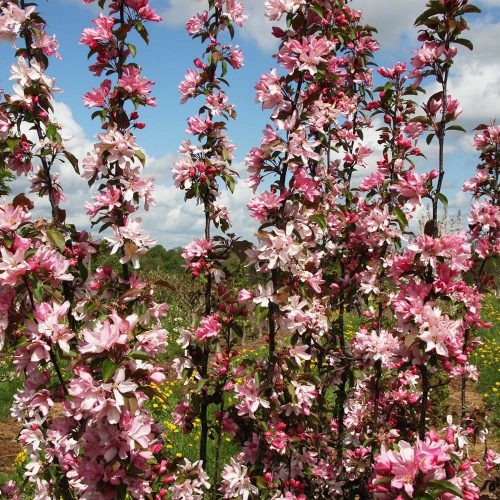
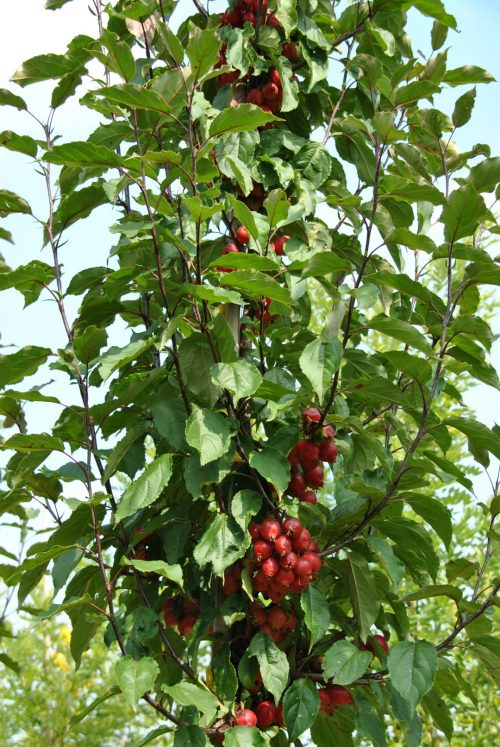 Malus 'Red Obelisk' Crab apple is a upright columnar tree that is perfect for small to medium sized gardens. Beautiful pinky white flowers in April & May with berries that follow in autumn. Plant Size • Mature Height: 3-4 metres • Mature Spread: 1-2 metres • Actual height 180-200cm • Pot size :10L Why We Love It • Fantastic amount of flowers in April and may. • massive amount of fruit in Autumn and winter. • bees land other wildlife love it. • Makes excellent jelly What To Know • Season of Interest: Spring, summer, autumn and winter interest • Position: Will do in sheltered or exposed sites. Likes full sun. • Soil: Moist but well drained, moderately fertile.
Malus 'Red Obelisk' Crab apple is a upright columnar tree that is perfect for small to medium sized gardens. Beautiful pinky white flowers in April & May with berries that follow in autumn. Plant Size • Mature Height: 3-4 metres • Mature Spread: 1-2 metres • Actual height 180-200cm • Pot size :10L Why We Love It • Fantastic amount of flowers in April and may. • massive amount of fruit in Autumn and winter. • bees land other wildlife love it. • Makes excellent jelly What To Know • Season of Interest: Spring, summer, autumn and winter interest • Position: Will do in sheltered or exposed sites. Likes full sun. • Soil: Moist but well drained, moderately fertile. -
Out of stock
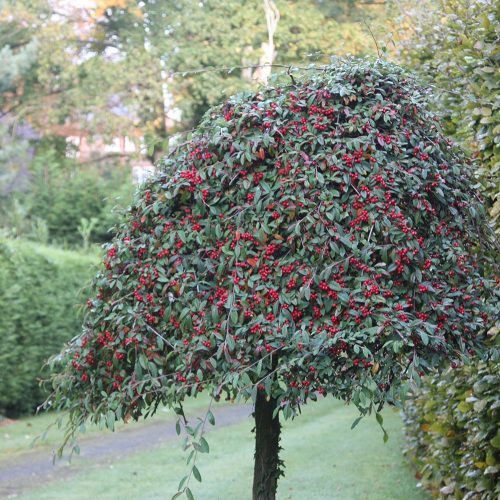
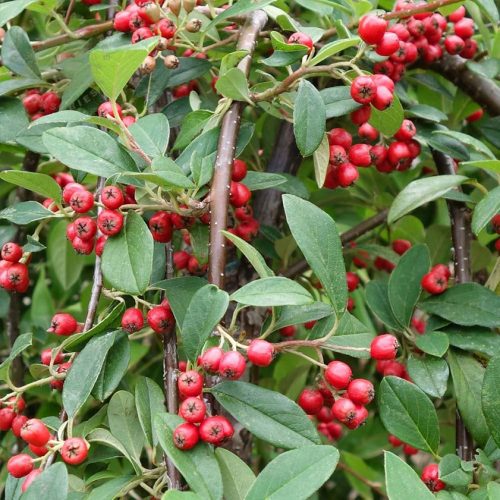 Cotoneaster Hybrida Pendula 'Hybridus Pendulus' is a vigorous prostrate evergreen shrub with large, elliptic leaves and small white flowers followed by profuse red berries in autumn; often top-grafted to form a pendulous small tree to 2m tall. CHARACTERISTICS: HARDINESS: Fully Hardy SOIL: moderately fertile, well-drained soil POSITION: Full Sun or Partial Shade FLOWERING PERIOD: June Fully Grown Height & Spread: 2m x 2m
Cotoneaster Hybrida Pendula 'Hybridus Pendulus' is a vigorous prostrate evergreen shrub with large, elliptic leaves and small white flowers followed by profuse red berries in autumn; often top-grafted to form a pendulous small tree to 2m tall. CHARACTERISTICS: HARDINESS: Fully Hardy SOIL: moderately fertile, well-drained soil POSITION: Full Sun or Partial Shade FLOWERING PERIOD: June Fully Grown Height & Spread: 2m x 2m -
Out of stock
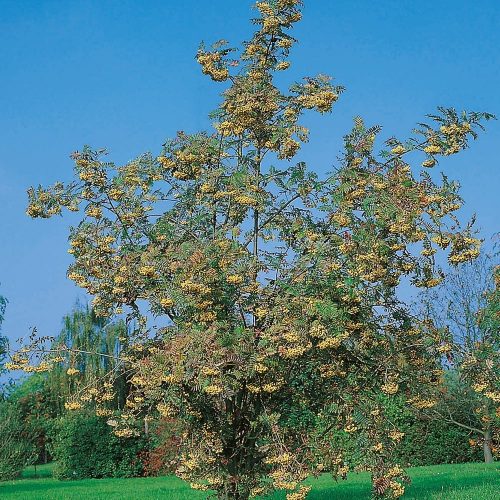
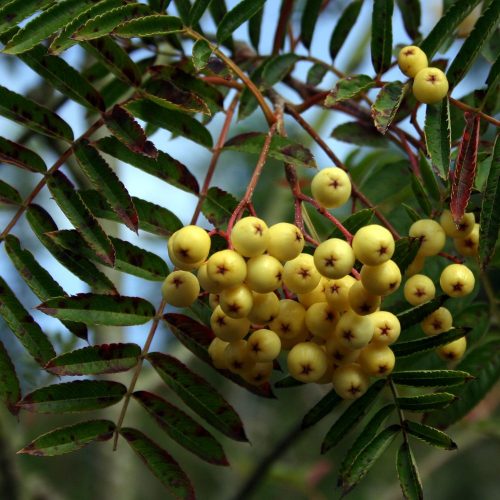 Sorbus Joseph Rock is a bright yellow-berried rowan tree very suitable for the small garden. It remains a great choice as a small tree for the small garden. A First-class tree with small, bright green leaflets that turn orange, purple and red in autumn. Clusters of white flowers appear in spring and are followed in autumn by small yellow berries, which birds love. It is an outstanding small tree which can tolerate a wide range of soils and conditions.
Sorbus Joseph Rock is a bright yellow-berried rowan tree very suitable for the small garden. It remains a great choice as a small tree for the small garden. A First-class tree with small, bright green leaflets that turn orange, purple and red in autumn. Clusters of white flowers appear in spring and are followed in autumn by small yellow berries, which birds love. It is an outstanding small tree which can tolerate a wide range of soils and conditions.- Max. Height & Spread: H-12m x S-8m
-
Out of stock
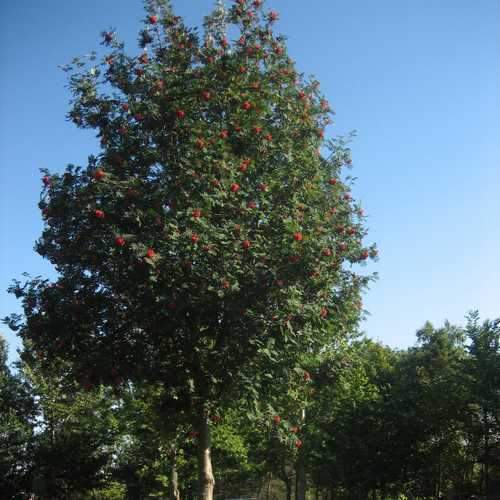
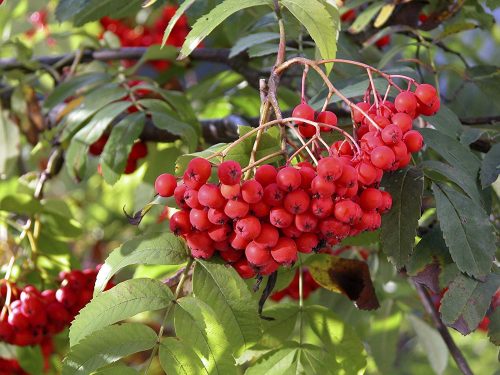 A cultivar of the native Irish rowan or mountain ash, Sorbus aucuparia ‘Sheerwater Seedling’ is a vigorous, medium-sized to tall tree of upright, narrow habit, the crown widening with maturity. It is often planted as a street tree. Creamy-white flowers appear in April–May, reliably followed by large clusters of long-lasting red berries in late summer. The leaves are grey-green, turning yellow and gold in autumn. A very easy, fast-growing, reliable tree, good for pollinators and birds. Plant in full sun for the best shape. Holds the RHS Award of Garden Merit. Site: Tolerates exposure Soil: Any reasonably well drained soil, acid to neutral soils preferred Position: Full sun Season of Interest: Spring, late summer, autumn Hardiness: Fully hardy Height: 40’ (12m) Spread: 13-26’ (4-8m)
A cultivar of the native Irish rowan or mountain ash, Sorbus aucuparia ‘Sheerwater Seedling’ is a vigorous, medium-sized to tall tree of upright, narrow habit, the crown widening with maturity. It is often planted as a street tree. Creamy-white flowers appear in April–May, reliably followed by large clusters of long-lasting red berries in late summer. The leaves are grey-green, turning yellow and gold in autumn. A very easy, fast-growing, reliable tree, good for pollinators and birds. Plant in full sun for the best shape. Holds the RHS Award of Garden Merit. Site: Tolerates exposure Soil: Any reasonably well drained soil, acid to neutral soils preferred Position: Full sun Season of Interest: Spring, late summer, autumn Hardiness: Fully hardy Height: 40’ (12m) Spread: 13-26’ (4-8m) -
Out of stock
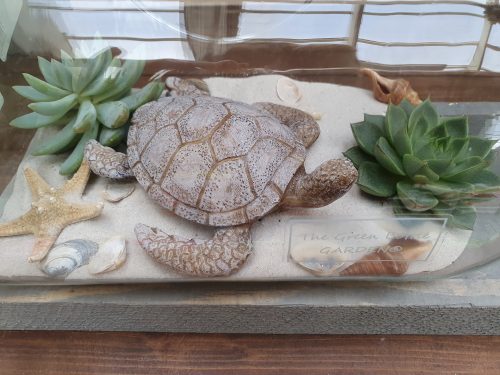
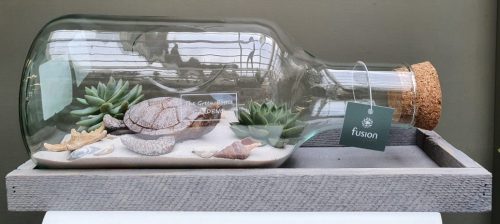
Inside a terrarium is a world of ideal peace. The cactus represents both strength and softness. The Terrarium is made entirely by hand by skilled artisans and will bring elegance and sophistication to your home, work or meditation space. It can be placed on a pedestal or as a centerpiece on a coffee table or side table. Cacti and succulents require very low maintenance making them ideal for anyone beginning to connect with plants.
Each plant is unique and will vary based on availability.
CARE INSTRUCTIONSPlace in bright indirect light, such as near a window or glass door. Make sure the arrangement is not direct sunlight as the rays of sun hitting glass acts as a magnifier and may burn the plants.
Start by watering once a month. Using a water bottle, spray each plant 3-5 times from the opening of the terrarium towards the soil (bottom) of the plants. Make sure the water spray evenly throughout the arrangement. Use a paper towel if necessary to clean the inside and outside glass. Let dry out completely between watering.
It is natural for each plant to have a different growth cycle. You may request a renovation service in our garden centre and can replace as many plants as necessary.
-
Out of stock
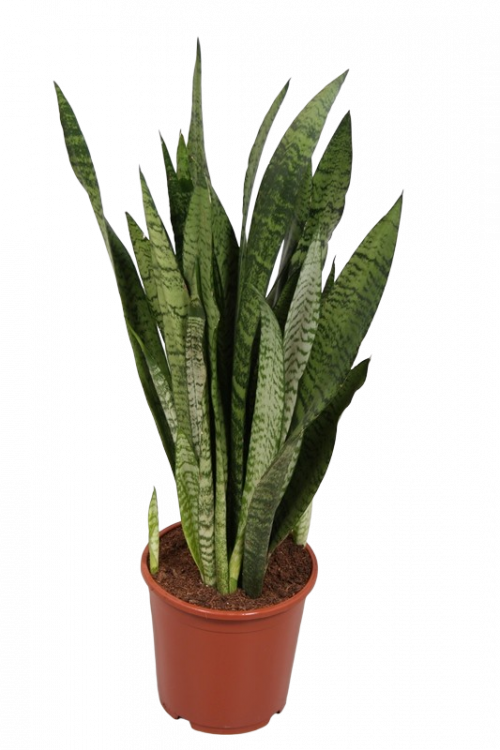 The Sanseveria zeylanica is almost indestructible and suitable for people who love separate modern forms. The Sanseveria is also an air-purifying plant and improves the humidity and creates a healthy atmosphere for body and soul. ~ 50 cm in height
The Sanseveria zeylanica is almost indestructible and suitable for people who love separate modern forms. The Sanseveria is also an air-purifying plant and improves the humidity and creates a healthy atmosphere for body and soul. ~ 50 cm in height -
Out of stock
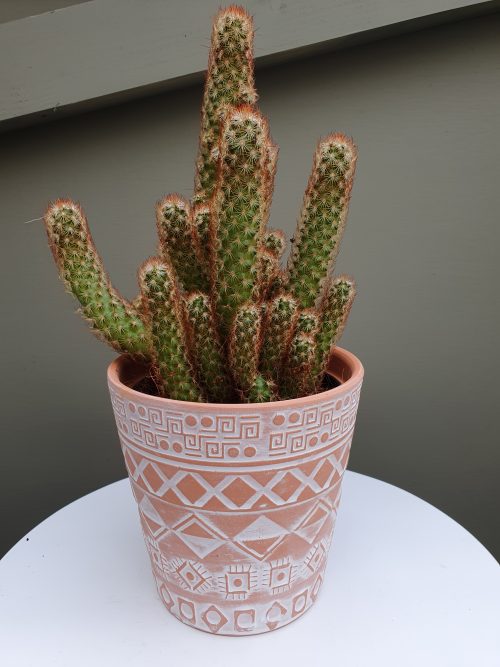
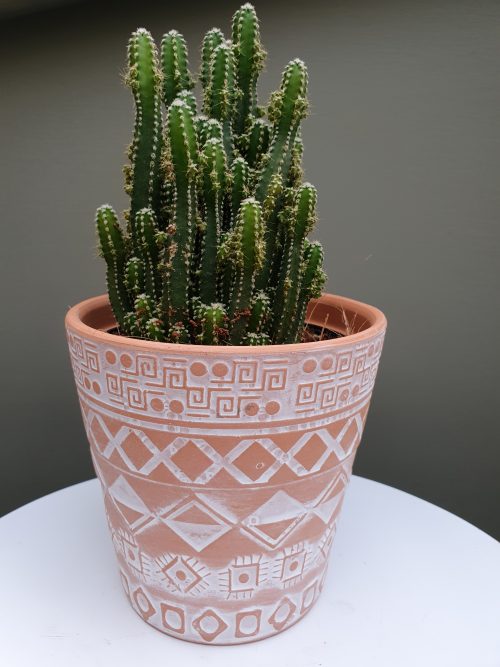 Cacti are now a very common houseplant. They come in a vast range of shapes and sizes from the petite to the grand.To care for a cactus plant, it is best to try to recreate their natural habitat. How to Care • Light Cacti thrive with good light sources, and it is best to place them in a bright place. A south facing position will provide good sunlight. However, be careful to not put them in direct sunlight because the intense light can make the plants turn a yellow colour. • Watering If your container has drainage holes, water thoroughly once a week during active growth period. If your container does not have drainage holes, water sparingly to moisten soil but be sure water does not pool up at the bottom of container which can cause rotting. Allow soil to dry between waterings. • Soil Cacti ike soil that is well aerated and fast draining. Perlite or pumice mixed with soil work well for this, or you can pick up cactus/succulent mix. • Fertilizer Fertilize during growing season with a 10-10-10 fertilizer diluted to 1/4 strength each watering. • Re-Potting If your cacti is pot-bound, then the best time to re-pot is in the spring. • Propagation Cacti have many methods for reproduction and can propagate from cuttings, leaf cuttings and producing pups and seeds.
Cacti are now a very common houseplant. They come in a vast range of shapes and sizes from the petite to the grand.To care for a cactus plant, it is best to try to recreate their natural habitat. How to Care • Light Cacti thrive with good light sources, and it is best to place them in a bright place. A south facing position will provide good sunlight. However, be careful to not put them in direct sunlight because the intense light can make the plants turn a yellow colour. • Watering If your container has drainage holes, water thoroughly once a week during active growth period. If your container does not have drainage holes, water sparingly to moisten soil but be sure water does not pool up at the bottom of container which can cause rotting. Allow soil to dry between waterings. • Soil Cacti ike soil that is well aerated and fast draining. Perlite or pumice mixed with soil work well for this, or you can pick up cactus/succulent mix. • Fertilizer Fertilize during growing season with a 10-10-10 fertilizer diluted to 1/4 strength each watering. • Re-Potting If your cacti is pot-bound, then the best time to re-pot is in the spring. • Propagation Cacti have many methods for reproduction and can propagate from cuttings, leaf cuttings and producing pups and seeds. -
Out of stock
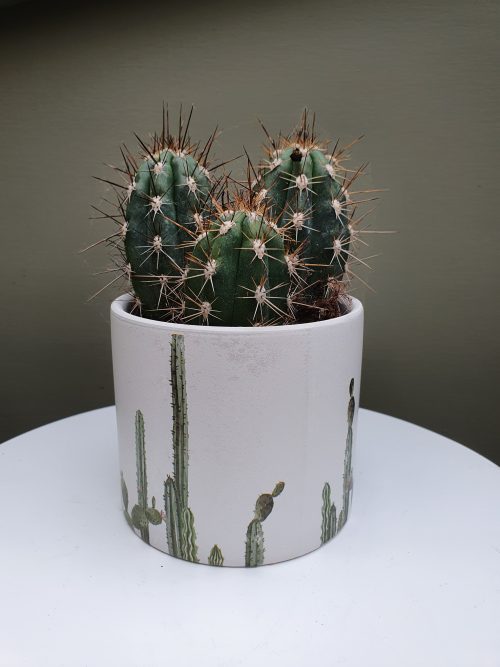 Cacti are now a very common houseplant. They come in a vast range of shapes and sizes from the petite to the grand.To care for a cactus plant, it is best to try to recreate their natural habitat. How to Care • Light Cacti thrive with good light sources, and it is best to place them in a bright place. A south facing position will provide good sunlight. However, be careful to not put them in direct sunlight because the intense light can make the plants turn a yellow colour. • Watering If your container has drainage holes, water thoroughly once a week during active growth period. If your container does not have drainage holes, water sparingly to moisten soil but be sure water does not pool up at the bottom of container which can cause rotting. Allow soil to dry between waterings. • Soil Cacti ike soil that is well aerated and fast draining. Perlite or pumice mixed with soil work well for this, or you can pick up cactus/succulent mix. • Fertilizer Fertilize during growing season with a 10-10-10 fertilizer diluted to 1/4 strength each watering. • Re-Potting If your cacti is pot-bound, then the best time to re-pot is in the spring. • Propagation Cacti have many methods for reproduction and can propagate from cuttings, leaf cuttings and producing pups and seeds.
Cacti are now a very common houseplant. They come in a vast range of shapes and sizes from the petite to the grand.To care for a cactus plant, it is best to try to recreate their natural habitat. How to Care • Light Cacti thrive with good light sources, and it is best to place them in a bright place. A south facing position will provide good sunlight. However, be careful to not put them in direct sunlight because the intense light can make the plants turn a yellow colour. • Watering If your container has drainage holes, water thoroughly once a week during active growth period. If your container does not have drainage holes, water sparingly to moisten soil but be sure water does not pool up at the bottom of container which can cause rotting. Allow soil to dry between waterings. • Soil Cacti ike soil that is well aerated and fast draining. Perlite or pumice mixed with soil work well for this, or you can pick up cactus/succulent mix. • Fertilizer Fertilize during growing season with a 10-10-10 fertilizer diluted to 1/4 strength each watering. • Re-Potting If your cacti is pot-bound, then the best time to re-pot is in the spring. • Propagation Cacti have many methods for reproduction and can propagate from cuttings, leaf cuttings and producing pups and seeds. -
Out of stock
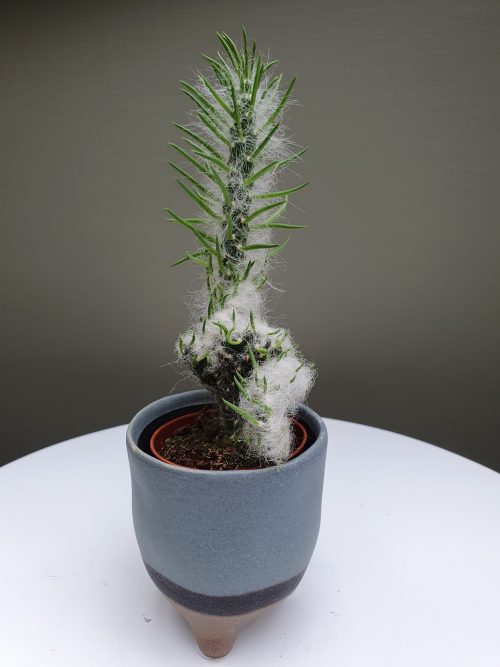
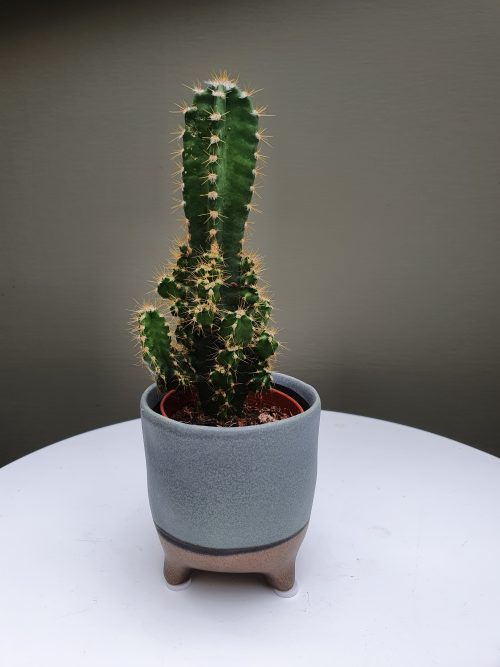 Cacti are now a very common houseplant. They come in a vast range of shapes and sizes from the petite to the grand.To care for a cactus plant, it is best to try to recreate their natural habitat. How to Care • Light Cacti thrive with good light sources, and it is best to place them in a bright place. A south facing position will provide good sunlight. However, be careful to not put them in direct sunlight because the intense light can make the plants turn a yellow colour. • Watering If your container has drainage holes, water thoroughly once a week during active growth period. If your container does not have drainage holes, water sparingly to moisten soil but be sure water does not pool up at the bottom of container which can cause rotting. Allow soil to dry between waterings. • Soil Cacti ike soil that is well aerated and fast draining. Perlite or pumice mixed with soil work well for this, or you can pick up cactus/succulent mix. • Fertilizer Fertilize during growing season with a 10-10-10 fertilizer diluted to 1/4 strength each watering. • Re-Potting If your cacti is pot-bound, then the best time to re-pot is in the spring. • Propagation Cacti have many methods for reproduction and can propagate from cuttings, leaf cuttings and producing pups and seeds.
Cacti are now a very common houseplant. They come in a vast range of shapes and sizes from the petite to the grand.To care for a cactus plant, it is best to try to recreate their natural habitat. How to Care • Light Cacti thrive with good light sources, and it is best to place them in a bright place. A south facing position will provide good sunlight. However, be careful to not put them in direct sunlight because the intense light can make the plants turn a yellow colour. • Watering If your container has drainage holes, water thoroughly once a week during active growth period. If your container does not have drainage holes, water sparingly to moisten soil but be sure water does not pool up at the bottom of container which can cause rotting. Allow soil to dry between waterings. • Soil Cacti ike soil that is well aerated and fast draining. Perlite or pumice mixed with soil work well for this, or you can pick up cactus/succulent mix. • Fertilizer Fertilize during growing season with a 10-10-10 fertilizer diluted to 1/4 strength each watering. • Re-Potting If your cacti is pot-bound, then the best time to re-pot is in the spring. • Propagation Cacti have many methods for reproduction and can propagate from cuttings, leaf cuttings and producing pups and seeds. -
Out of stock
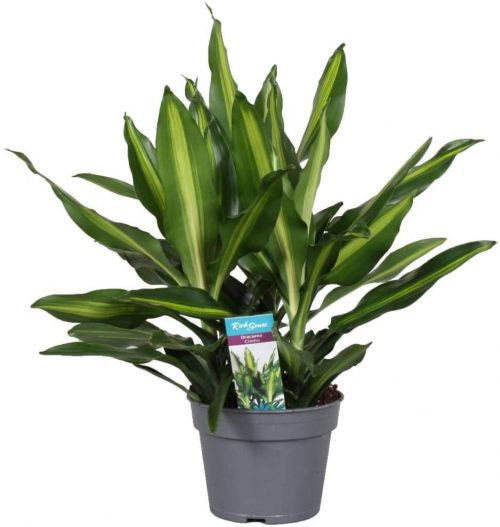
- The Dracaena is ideally suited for a shade in the room or office, rather than direct sunlight. In general, the darker the leaves all the more shadow can endure the plant. ~ 50cm in height
-
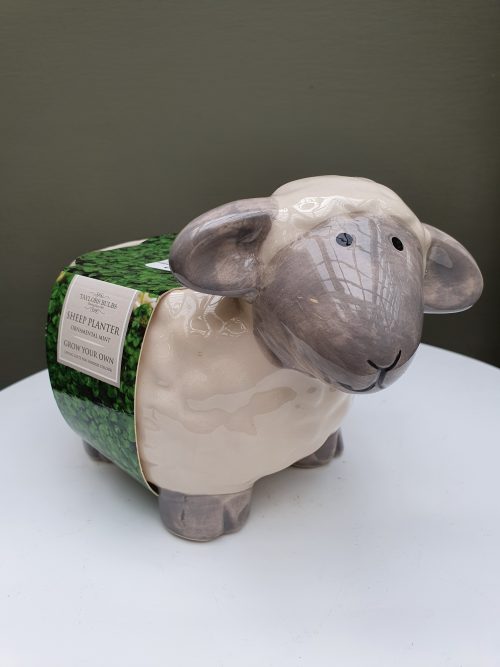 Sheep shaped ceramic planter with seeds, compost and growing culturals. Contains 1 x packet miniature mint seeds Indoor growing intructions: Plant from August onwards, by emptying two thirds of the compost into the planter. Then place the bulbs on top (pointy side uppermost) and cover them with the remaining compost, firming it down gently. Water sparingly so the compost is just moist, but be careful not to overwater. Place the planter in a bright position and try to maintain temperatures around 18-20C. Once in flower, move the planter to a cool, bright room to help prolong the display. Turn the hedgehog occasionally, and keep the compost moist but not waterlogged at all times. When the flowers have finished blooming, the bulbs can be planted outside in the garden.
Sheep shaped ceramic planter with seeds, compost and growing culturals. Contains 1 x packet miniature mint seeds Indoor growing intructions: Plant from August onwards, by emptying two thirds of the compost into the planter. Then place the bulbs on top (pointy side uppermost) and cover them with the remaining compost, firming it down gently. Water sparingly so the compost is just moist, but be careful not to overwater. Place the planter in a bright position and try to maintain temperatures around 18-20C. Once in flower, move the planter to a cool, bright room to help prolong the display. Turn the hedgehog occasionally, and keep the compost moist but not waterlogged at all times. When the flowers have finished blooming, the bulbs can be planted outside in the garden.- Harmful if eaten/skin irritant
-
Out of stock
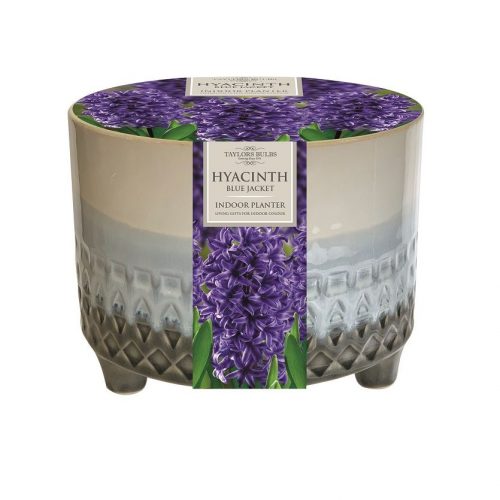 Glazed ceramic planter, bulbs, compost and growing culturals. Dimensions 17cm x 13cm Contains 3 x Hyacinth Blue Jacket Bulbs Indoor growing intructions: Plant from August onwards, by emptying two thirds of the compost into the planter. Then place the bulbs on top (pointy side uppermost) and cover them with the remaining compost, firming it down gently. Water sparingly so the compost is just moist, but be careful not to overwater. Place the planter in a bright position and try to maintain temperatures around 18-20C. Once in flower, move the planter to a cool, bright room to help prolong the display. Turn the hedgehog occasionally, and keep the compost moist but not waterlogged at all times. When the flowers have finished blooming, the bulbs can be planted outside in the garden.
Glazed ceramic planter, bulbs, compost and growing culturals. Dimensions 17cm x 13cm Contains 3 x Hyacinth Blue Jacket Bulbs Indoor growing intructions: Plant from August onwards, by emptying two thirds of the compost into the planter. Then place the bulbs on top (pointy side uppermost) and cover them with the remaining compost, firming it down gently. Water sparingly so the compost is just moist, but be careful not to overwater. Place the planter in a bright position and try to maintain temperatures around 18-20C. Once in flower, move the planter to a cool, bright room to help prolong the display. Turn the hedgehog occasionally, and keep the compost moist but not waterlogged at all times. When the flowers have finished blooming, the bulbs can be planted outside in the garden.- Harmful if eaten/skin irritant
-
Out of stock
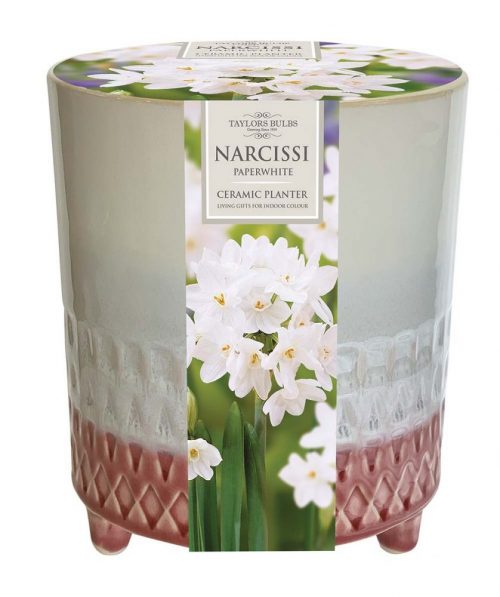 Glazed ceramic planter containing 3 x Narcissi Paperwhite bulbs, compost and growing culturals.
Glazed ceramic planter containing 3 x Narcissi Paperwhite bulbs, compost and growing culturals.- Indoor growing intructions: Plant from August onwards, by emptying two thirds of the compost into the planter. Then place the bulbs on top (pointy side uppermost) and cover them with the remaining compost, firming it down gently. Water sparingly so the compost is just moist, but be careful not to overwater. Place the planter in a bright position and try to maintain temperatures around 18-20C. Once in flower, move the planter to a cool, bright room to help prolong the display. Turn the hedgehog occasionally, and keep the compost moist but not waterlogged at all times. When the flowers have finished blooming, the bulbs can be planted outside in the garden.
- Harmful if eaten/skin irritant
-
Out of stock
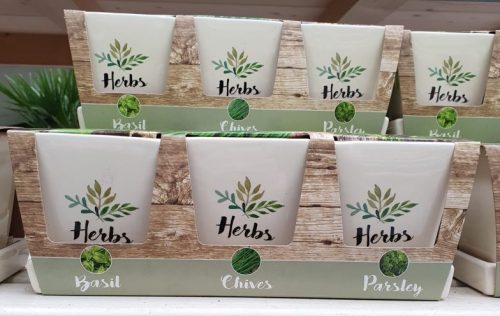
- Grow your own herb kit in attractive ceramic pots
- A wonderful gift for birthdays, Christmas, Mother's Day and all occasions
- Contains soil & seeds for basil, chives and parsley
- Gift boxed, and with full instructions
- A wonderful present for anyone who enjoys cooking with fresh herbs
-
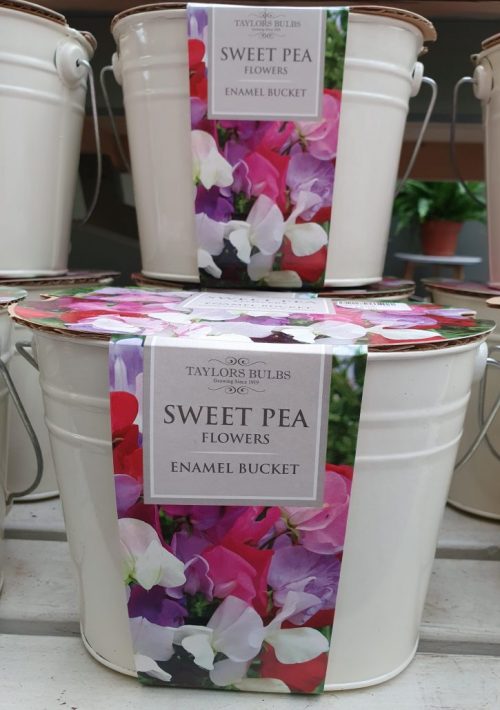
- This is a great little gift set that includes everything you will need to grow your own crop of sweet peas. These much-loved annual climbers produce their (often highly scented) flowers in summer, and if these are picked regularly for the vase, it will encourage even more to form.
- Indoor growing instructions: Prior to sowing, soak the seeds in water for 24 hours (indoors) as this aids germination. Fill 80% of the planter with compost and moisten. Scatter seeds evenly on the surface and cover with a very thin layer of compost and moisten. Move to a warm well lit area; a windowsill is ideal but full sunshine will dry out the compost rapidly. The compost must be kept moist at all times. Seeds will germinate aftre approximately 3-4 weeks. Plants will flower after approximately 12 weeks from sowing. Turn occasionally as the flowers will grow towards the light. Remove dead flowers regularly. After purchase store in a cool dry place.
- Contents: Miniature Sweetheart Mix Sweet pea seeds & compost.